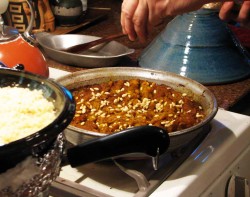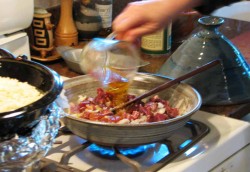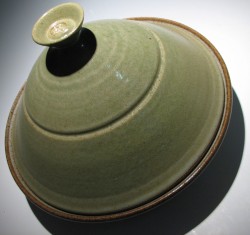TAGINE, the name of both the dish and the pot it is cooked in, are traditionally done on the stovetop so the moisture condenses on the cool stoneware top and drops back into the Clay Coyote Flameware dish.The lid on the tagine is designed to encourage this condensation. The necessary moisture loss (to thicken the broth) occurs in the fit between the lid and base. The big advantage of the Clay Coyote Flameware Tagine, over earthenware, is that you can do any high temperature pre-cooking like sautéing onions, garlic, browning meat, then lower the heat to cook the traditionally simmered tagine. This piece can bake, broil, stew, simmer, saute, and serve.

We will be posting our favorite tagine recipes this month, as well as experimenting with new uses for the dish. I just received a tagine for my birthday. If you have been considering adding a tagine to your collection, March is the time to do it. We have a variety to chose from in our gallery. We also have a nice selection in our studio waiting to be glazed.
This is from Paula Wolfert’s Mediterranean Clay Pot Cooking book. We made this for our summer dinner party. It was amazing.
Winter Sqh and Toasted Pine Nuts
2 pounds thick bone in lamb shoulder arm chops
2 1/2 to 3 pounds butternut squash
Coarse salt
1/8 teaspoon saffron threads
1 large onion, grated, plus 2 medium onions, sliced
Salt and freshly ground pepper
2 teaspoons La Kama
2 teaspoons smen (optional)
Pinch ground cinnamon
Pinch ground ginger
1 Tablespoon lavender or orange flower honey
3 tablespoons unsalted butter
2 tablespoons pine nuts, toasted
1. Trim any excess fat from the lamb. Cut the chops into 1 1/2 inch chunks with the bones.
2. Peel the squash and scrape out the seeds and membrane. Shred the squash. Sprinkle liberally with coarse salt and drain in a colander for about 1 hour. At the same time, soak the saffron in 1/3 cup warm water.

3. Place the lamb, grated onion, saffron, and its water, 1 teaspoon salt, 1 1/2 teaspoons of La Kama, and the smen in the tagine. Stir to mix well. Cover and cook on low heat for 1 1/2 hours.
4. Stir the sliced onions and continue to cook, covered, for 1 hour longer. Pick out the pieces of lamb and let stand until cool enough to handle. Cut out and discard the bones. Skim off the cooking liquid in the tagine. Season the meat with salt and pepper and return to the tagine.
5. Rinse the grated squash under cold running water and squeeze in your hands over a bowl to catch the juices. Measure out and reserve 2 tablespoons of the juice; discard the remainder. Place the grated squash in a 10 inch clay skillet. Add the cinnamon, ginger, honey, remaining La Kama, 2 tablespoons of the butter, and the reserved 2 tablespoons of squash liquid. Slowly fry until the squash is thickened to a jam like consistency and colored a golden carmel, about 15 minutes.
6. Preheat oven to 300F. Ladle 1/2 the sauce from the tagine over the squash and stir to combine. Spread the squash and stir to combine. Spread the squash evenly over the lamb. Dot with the remaining 1 tablespoon butter and place tagine in the top third of the oven. Raise heat to 425F and bake, uncovered, until the squash is lightly glazed, about 30 minutes. Remove from oven, be sure to set the tagine down on a wooded surface. Serve the tagine hot or warm, with the pine nuts scattered on top.
Do you have a delicious tagine recipe to share? We will be selecting one recipe to feature here on our blog. Send in your ideas, and you could be the March feature.

